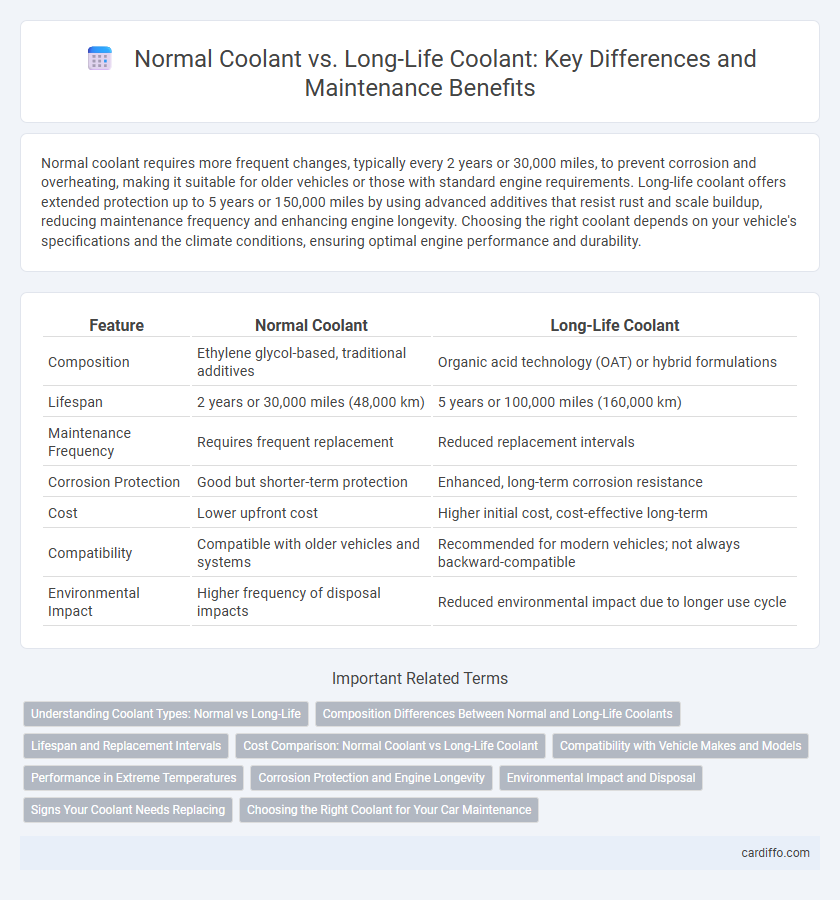Normal coolant requires more frequent changes, typically every 2 years or 30,000 miles, to prevent corrosion and overheating, making it suitable for older vehicles or those with standard engine requirements. Long-life coolant offers extended protection up to 5 years or 150,000 miles by using advanced additives that resist rust and scale buildup, reducing maintenance frequency and enhancing engine longevity. Choosing the right coolant depends on your vehicle's specifications and the climate conditions, ensuring optimal engine performance and durability.
Table of Comparison
| Feature | Normal Coolant | Long-Life Coolant |
|---|---|---|
| Composition | Ethylene glycol-based, traditional additives | Organic acid technology (OAT) or hybrid formulations |
| Lifespan | 2 years or 30,000 miles (48,000 km) | 5 years or 100,000 miles (160,000 km) |
| Maintenance Frequency | Requires frequent replacement | Reduced replacement intervals |
| Corrosion Protection | Good but shorter-term protection | Enhanced, long-term corrosion resistance |
| Cost | Lower upfront cost | Higher initial cost, cost-effective long-term |
| Compatibility | Compatible with older vehicles and systems | Recommended for modern vehicles; not always backward-compatible |
| Environmental Impact | Higher frequency of disposal impacts | Reduced environmental impact due to longer use cycle |
Understanding Coolant Types: Normal vs Long-Life
Normal coolant typically requires replacement every 2 to 3 years or 30,000 miles, providing basic protection against freezing and overheating. Long-life coolant, formulated with advanced additives, offers extended protection up to 5 years or 100,000 miles, reducing corrosion and improving engine longevity. Selecting the appropriate coolant type depends on manufacturer specifications and vehicle usage to ensure optimal engine maintenance and performance.
Composition Differences Between Normal and Long-Life Coolants
Normal coolant typically contains inorganic additives such as silicates, phosphates, and nitrates that provide short-term protection against corrosion and freezing. Long-life coolant incorporates organic acid technology (OAT) inhibitors, which offer extended protection by forming a durable, passivating layer on metal surfaces, reducing the need for frequent changes. The chemical formulation in long-life coolant enhances compatibility with modern engine materials and increases thermal stability compared to traditional coolants.
Lifespan and Replacement Intervals
Normal coolant typically has a lifespan of around 2 to 3 years or 24,000 to 36,000 miles, requiring more frequent replacement to maintain engine protection. Long-life coolant extends the replacement interval significantly, often lasting up to 5 years or 150,000 miles due to advanced corrosion inhibitors and stabilized formulations. Using long-life coolant reduces maintenance frequency and helps prevent overheating and corrosion more effectively over time.
Cost Comparison: Normal Coolant vs Long-Life Coolant
Normal coolant typically requires replacement every 2 years or 30,000 miles, resulting in lower upfront costs but higher long-term maintenance expenses. Long-life coolant, lasting up to 5 years or 150,000 miles, offers cost savings by reducing the frequency of flushes and replacements despite a higher initial price. Over time, the extended durability of long-life coolant often leads to lower total ownership costs due to decreased labor and product usage.
Compatibility with Vehicle Makes and Models
Normal coolant typically suits older vehicle makes and models with conventional engine designs, ensuring basic antifreeze and corrosion protection but may require more frequent changes. Long-life coolant is formulated with advanced additives to be compatible with a wider range of modern vehicles, including European and Asian manufacturers, providing extended protection intervals and superior compatibility with aluminum and mixed-metal engines. Always consult the vehicle's owner manual or manufacturer specifications to confirm the correct coolant type to prevent corrosion, overheating, and maintain warranty compliance.
Performance in Extreme Temperatures
Normal coolant typically offers effective heat transfer and freeze protection within standard temperature ranges but may degrade faster under extreme heat or cold, requiring more frequent replacement. Long-life coolant contains advanced additives that enhance thermal stability and corrosion resistance, maintaining optimal engine temperature regulation even in severe hot or cold conditions. Vehicles operating in extreme climates benefit from long-life coolant's extended performance, reducing the risk of overheating or freezing and extending maintenance intervals.
Corrosion Protection and Engine Longevity
Normal coolant typically requires replacement every 2 years and offers basic corrosion protection suitable for older engine designs, while long-life coolant extends replacement intervals up to 5 years due to advanced anti-corrosion additives that protect modern engine components more effectively. The superior formulation of long-life coolant minimizes metal deterioration and reduces wear on critical engine parts, thereby enhancing engine longevity and maintaining optimal performance over time. Choosing long-life coolant supports better maintenance intervals and ensures prolonged durability and reliability of the cooling system.
Environmental Impact and Disposal
Normal coolant typically contains ethylene glycol, which is toxic and poses significant environmental risks if improperly disposed of, requiring careful handling and recycling. Long-life coolant often uses organic acid technology, resulting in extended service intervals and reduced coolant waste, minimizing environmental impact. Both types necessitate adherence to local disposal regulations to prevent soil and water contamination.
Signs Your Coolant Needs Replacing
Coolant that appears rusty, discolored, or contains debris indicates it needs replacing to prevent engine corrosion and overheating. A sweet, syrupy smell or frequent engine overheating are clear signs that normal coolant has degraded or long-life coolant has reached the end of its effective lifespan. Regular inspection of coolant levels and clarity, especially with long-life formulas designed to last up to 5 years or 150,000 miles, helps maintain optimal engine performance and longevity.
Choosing the Right Coolant for Your Car Maintenance
Choosing the right coolant for your car maintenance depends on the vehicle manufacturer's specifications, engine type, and driving conditions. Normal coolant typically requires more frequent changes, usually every 2 years or 30,000 miles, while long-life coolant can last up to 5 years or 150,000 miles due to advanced corrosion inhibitors and additives. Using the recommended coolant type helps prevent overheating, corrosion, and engine damage, ensuring optimal performance and longevity of your car's cooling system.
Normal Coolant vs Long-Life Coolant Infographic

 cardiffo.com
cardiffo.com